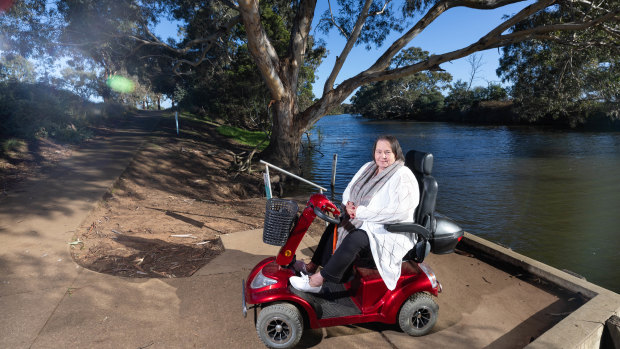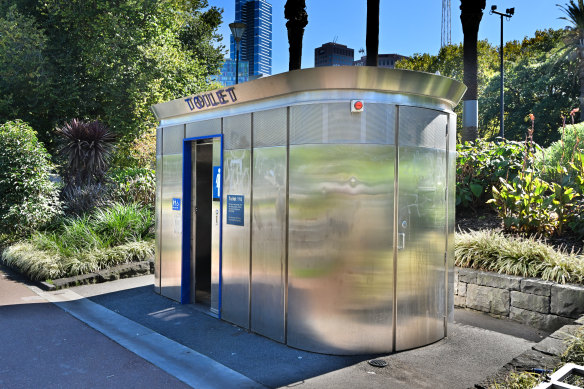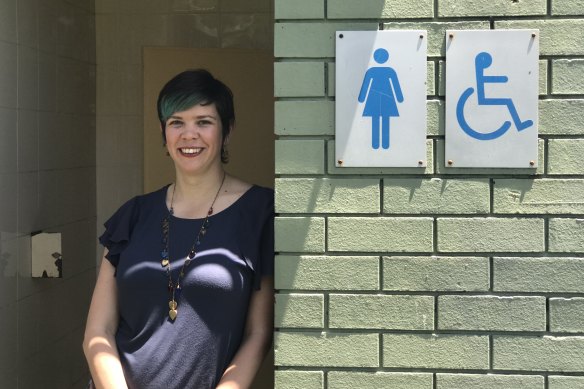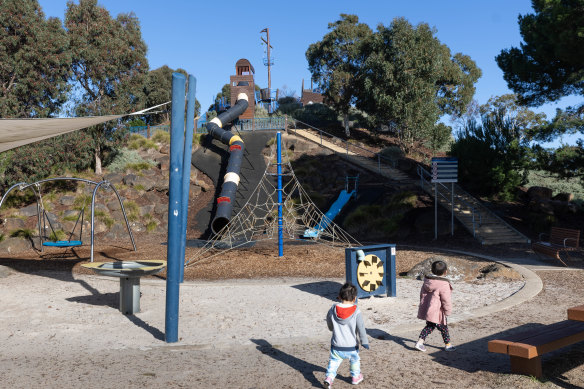This was published 2 years ago
Why aren’t these suburbs flush with dunnies? Tracking Melbourne’s public toilet deserts
There are picnic tables, a scenic walking trail and a canoe landing area – but a leisurely afternoon along the banks of the Werribee River at Riverbend Historical Park would likely be cut short by one missing element: there’s no toilet.
“There have been barbecues here since I was a kid. It’s not a new park,” says 51-year-old Werribee resident and community advocate Lisa Heinrichs. “But there’s still no public toilet here.”

Lisa Heinrichs says Werribee’s Riverbend Historical Park is a popular spot for visitors in need of public toilets.Credit: Jason South
They are known as “public toilet deserts”: pockets of suburbs where a busting bladder can’t find a public toilet within in a reasonable walking distance. And they restrict residential participation in the community, hence another public health term describing the problem, “loo leashes”.
For visitors and Werribee residents, including families with children and elderly residents, who frequent the historical park, the closest public toilet is a 45-minute hike down river to Wyndham Park.
Wyndham, on Melbourne’s western fringe, is among the worst metropolitan council areas for the number of public toilets per 100,000 residents, according to The Sunday Age’s analysis of National Public Toilet Map data and 2021 Australian Bureau of Statistics population figures.
Wyndham is in the bottom five councils for public toilet numbers, alongside fellow western suburban municipalities Brimbank, Hume and Melton, as well as Casey in Melbourne’s outer south-east.

A public toilet in Melbourne’s Queen Victoria Gardens. There are no rules dictating the number and location of restrooms in the city.Credit: Joe Armao
Heinrichs, who has mobility issues, says there are not enough public toilets in Wyndham, let alone enough that are fully accessible.
“My biggest fear is being in public and having to change my colostomy bag. Toilets aren’t the best place to do that. We need toilets that are fully accessible, have hoists and are clean,” says Heinrich, who has been lobbying the council for more toilets for two years.
Comparing all 31 metropolitan council areas shows there is a massive variance in local loos: atop the list is inner-city Yarra with 98 public toilets per 100,000 residents, which is five times as many as Casey, at the bottom and with just 18 toilets per 100,000 people.
There is no legislative requirement to ensure people have adequate access to public toilets, which is a factor in their patchy distribution, says public toilet researcher Katherine Webber.
“We’ve got building codes that say if you’ve got a building with this many people using it, you must provide this many toilets – but as soon as we leave buildings, local governments don’t have that guidance,” says Webber, who was awarded a Churchill Fellowship to study global best practice public toilet policy.
“If it’s not a requirement, they’re [considered] an extra, which is why you’re not going to spend the extra budget on them.”
Webber has advocated to change the perception of public toilets in Australia to regard them less of a burden and more as a fundamental human right, and economic enablers for communities.
“If you want people to keep shopping on a high street, they’re going to need a toilet at some point,” she says.

Katherine Webber received a Churchill Fellowship to research public toilets and regards them as a human right.
“If you look at a grey nomads notice board, people will drive further to a place that has a good bakery and a good public toilet.”
According to recent Wyndham Council papers, the council admits the distribution of toilets across the municipality has gaps and is “not equitable”. It is now committed to installing 30 new toilets across the municipality “as funds permit”, and for the past month has asked residents where they should be located.
Many of the suggested spots are in parks in newly established housing estates.
Bayview Park, in the Alamanda housing estate in Point Cook, desperately needs a public toilet, says Heinrichs, who takes her grandchildren to the playground known as the “Pirate Ship Park”.
The destination playground has a basketball court, barbecue facilities and picnic tables and attracts families from other parts of Melbourne. But the nearest public toilet is 20-minute walk or a five-minute drive.
But public toilet placement can be controversial: multiple residents in the immediate vicinity of Bayview Park on the council’s feedback map pushed back on any plans for a public toilet fearing it would attract anti-social behaviour. A firebug previously vandalised the park.
Moonee Valley Council in Melbourne’s inner-west is currently considering where to place 10 public toilets after the area’s parks became overrun with visiting residents during lockdowns.
Some of Melbourne’s 31 councils don’t have public toilet strategies, including Melton and Casey. A spokeswoman for Casey said the council was working on a policy for the area’s “rapidly growing population”.

The popular “Pirate Ship Park” in Point Cook attracts visitors from across Melbourne but has no public toilets.Credit: Jason South
“Council strives to manage urban growth and maintain a high level of service and infrastructure delivery for the community while balancing its financial responsibilities and competing infrastructure demands,” she said.
Webber wants to see state and federal grants for councils explicitly for public toilets, as restrooms currently compete with other infrastructure for priority funding. She also wants implemented standard best-practice public toilet strategies for councils to follow.
“No one really has that [sole] responsibility,” she says. “[Unfortunately] there’s no public toilet planners.”
The Morning Edition newsletter is our guide to the day’s most important and interesting stories, analysis and insights. Sign up here.